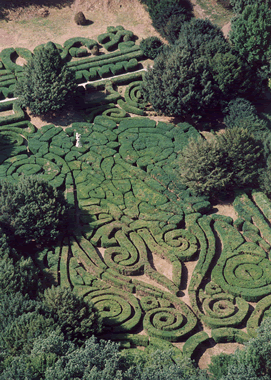Tézisek:
1. Mint textilművész, aki motívumokkal
építkezik és munkáit, belső érzelmek hatására készíti, szükségem volt a
motívumok értésére. Érteni akartam azt,
amit ösztönösen jól találtam ki, Érdekelt, miért
tűntek el a tarsolylemezekről az addig folyamatosan fellelhető, s a
nagyszentmiklósi kincsben is szereplő turulok, griffek, szarvasok, lovak,
oroszlánok, ezek miért jöttek elő az árpád-kori kőfaragásban? Továbbá miért
tűntek el maguk a tarsolylemezek?
2. A szimbolikus gondolkodásmód eszköztárát
megismerni annyit jelent, mint a kultúra egyik fontos beszédmódját megtanulni,
megérteni a gondolat kifejezésének egyedül a magyar emberre jellemző módját. A
jelképek vállalásával egy csoporthoz való tartozást tudatosítunk. Valójában az izgatott, hogy mi tarthatja életben,
emlékezetben ezeket a különleges motívumokat, mint a szarvas, páva, galamb,
életfa, és a sárkány. Mi adja az úgynevezett magyaros jelleget?
Azt is furcsának
találtam, hogy a palmetta motívum elterjedését a romanikában külföldi
mesterektől származtatjuk, holott a tarsolylemezeken egy olyan kimagasló
teljesítmény mutatkozik, mely akkor Európa más területein még nem volt. Előtte pedig, fellelhető akár a magyar
kelta anyagban is. A kígyófonás is a
kelta korig visszakövethető.
3. Mindenfajta vallási és
hatalmi viszálykodás ellenére a kereszténységre áttérő magyarság még egységes
lelkisége olyan erővel oltja át sajátos energiáit, jellemét, szemléletét a
honfoglaláskori művészetből a romanikába, hogy máig ezt tarthatjuk a legmagyarabb
szobrászati stíluskorszaknak.
4. Természetesen a népnevek, mint támpontok, történelmi
fogódzók megtartása mellett látnunk kell, hogy egy népesség (ellentétben egy népnévtől) nem pattan elő a semmiből, a föld alól, hanem folyamatok eredménye.
Az új név alatt feltűnő népek az ott
élőket magukba olvasztják.
A
sztyeppei civilizációban általában exogám házasulási szokásokat találunk. A
győztesek elrabolják a legyőzöttek asszonyait. (Dúl leányi legszebb kettő).→Keveredés. A peremvidékekre telepítik a legyőzött
népeket, védelmi pozícióul.
A nyelvi
sokszínűség és viszonylag autonóm uralmi struktúra, illetve a távoli
külkapcsolatok miatt viszonylag gyorsan tűnnek fel és el államalakulatok és
birodalmak. Ez nem járt a teljes népesség elvándorlásával, kiirtásával. A szövetséges törzsek közösségei vagy a behódolt
népek gyakran felveszik az új államalakulat vagy vezető törzsszövetség nevét→
mimikri, amely a megváltozó hatalmi
struktúra révén az egyes közösségek egy helyben maradása esetén is változásnak
tűnhet. Ezekben az esetekben a motívumok árulkodóak lehetnek. A
motívumok nagyon sokáig őrzik ősiségüket. Az ősképek a tudatalattinkat nyitják
meg. Olyan képeket akarok létrehozni, amelyek ezt az összeolvadást fedik fel: a
rétegek egymásra épülését, ellentétes irányút a régészével, aki szétválaszt.
legalább is úgy gondoltam. Autodidaktaságom miatt próbáltam meg végig
menni inkább a vizuális tényeken, a nyelvészet, néprajz, szokások, mesék
összehasonlító elemzése helyett, de a történelmet nem lehetett megkerülni.
Theses:
1. As a textile artist who used motifs to build works
inspired by emotions, I felt a need to understand motifs. I wanted to
understand what I hoped I was using properly instinctively. Being self-taught I
preferred visual evidence to linguistics, folklore, customs and comparative
analysis of stories, but history proved impossible to avoid.
I was intrigued to know why turuls, griffons, deer, horses,
lions, all of which had always been conspicuous and also featured in the Treasure
of Nagyszentmiklós, suddenly disappeared only to reemerge in Árpád Age stone
carvings. Furthermore, I asked, why did the sabretache plates themselves
disappear?
2. Learning to know the tools of symbolic thinking means learning
to use an important cultural idiom; understand how ideas are expressed in a
manner typical of Hungarians. I was really intrigued to know what was it that
kept alive the memory of these curious motifs – the Deer, the Peacock, the
Dove, the Tree of Life, and the Dragon? Where does that so-called Hungarian
character come from?
One thing I found odd was that the palmette motif in Hungarian Romanesque
art was attributed to foreign craftsmen in spite of the fact that the artistic
quality of sabretache plates was unparallelled in contemporary Europe, and is also
present in Celtic artifacts of Hungarian
provenance. The serpent braid can be traced back to the Celtic age as well.
3. In spite of all kinds of religious and power strifes,
Romanesque art in Hungary was
so imbued with the spirit, energy, character, and specific outlook of
Hungarians (freshly converted to Christianity), that it remains the most
typically Hungarian style in the history of sculpture in Hungary.
4. While
ethnic names are useful as points of reference, it is important to see that an
ethnicity (unlike a name used for an ethnicity) does not emerge from thin air
but is the product of long processes. Ethnicities emerging in a territory under
a new name assimilate the people who have been living there before their
arrival.
In steppe cultures,
exogenous marital patterns used to be quite typical. Conquerors would abduct
the women of the conquered (see the rape of Dúl’s daughters in Arany’s Legend
of the Woundrous Hunt). → Merging. The vanquished would then be settled in
frontier areas.
Empires would
emerge and disappear at a fairly quick pace due to linguistic diversity, a
relatively autonomous power structure, and distant external relations. This
however would not entail the migration or disappearance of entire populations.
Tribal alliances and conquered people would often assume the name of the new
empire or that of the leading tribe (→ mimicry) which might suggest a change
thanks to a shift in the power structure despite the fact that local
communities had not moved at all. In such cases, motifs might be quite revealing while
conserving ancient patterns. Archetypes open the door to our subconscious. It
is my goal to create images that reveal this merger, this superimposition of
layer upon layer, an ambition quite different from that of archeologist who
intends to take things apart.


